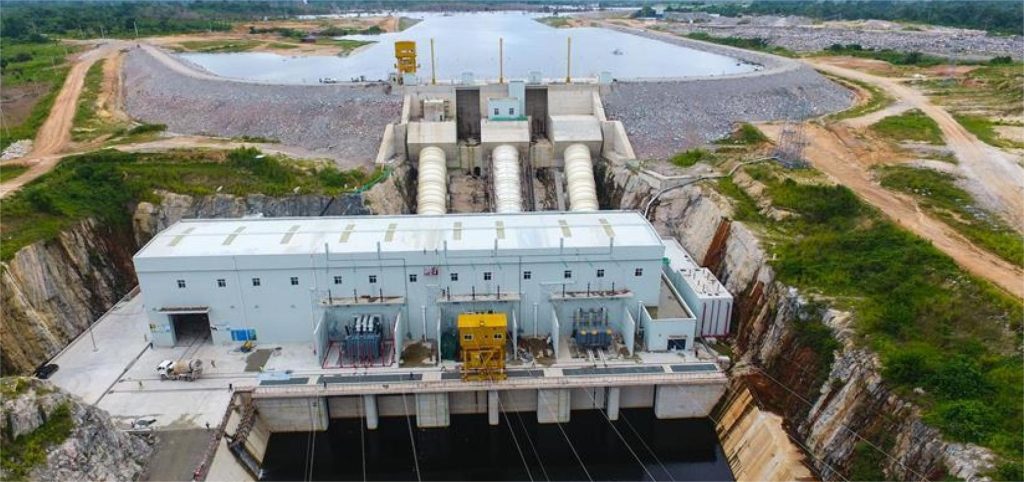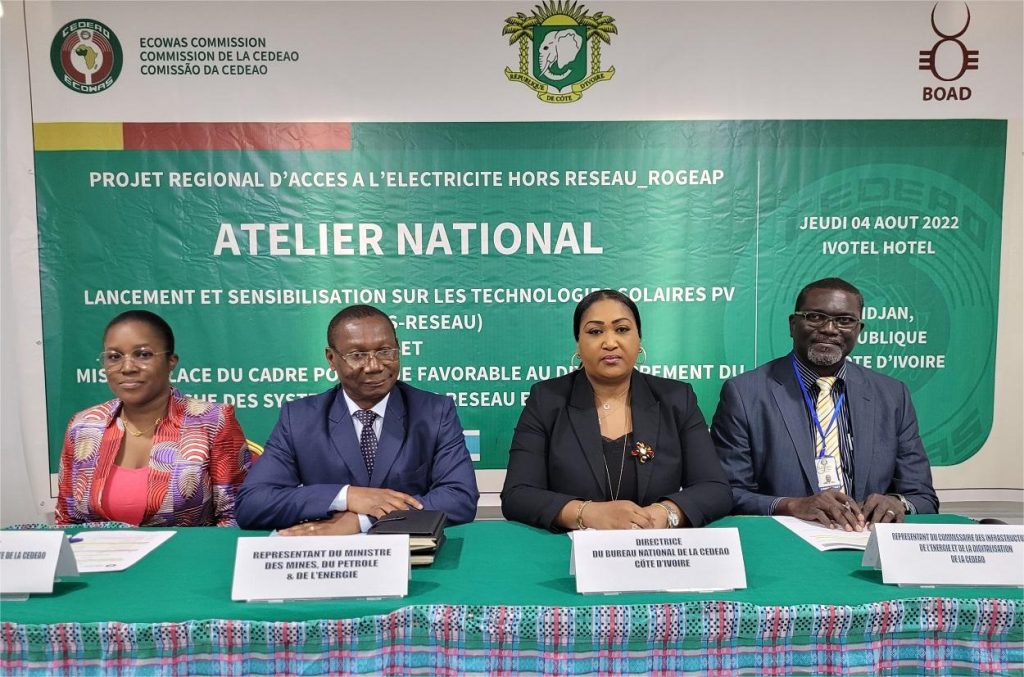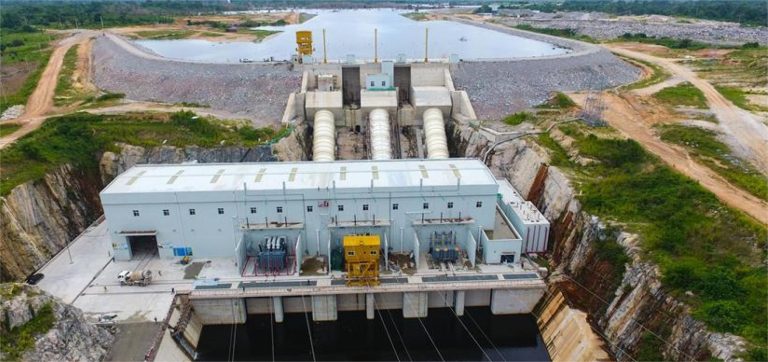Brief introduction for Cote d’Ivoire
Cote d’Ivoire, also known as Ivory Coast, is a country in West Africa bordered by the Gulf of Guinea. Neighboring countries include Liberia, Guinea, Mali, Burkina Faso, and Ghana. Cote d’Ivoire is mostly flat with mountains in the northwest and a forested interior. The government system is a public, multiparty presidential regime. The chief of state is the president, and the head of government is the prime minister. Cote d’Ivoire has a mostly traditional economic system in which the economy is heavily dependent on agriculture and related activities. Cote d’Ivoire is a member of the Economic Community of West African States (ECOWAS).

Energy resources, especially electricity
Côte d’Ivoire’s robust economic growth in the years since the country regained political stability in 2011 has resulted in a surge in energy consumption, particularly in urban areas. As of 2020 the electricity sector was the third largest in Africa in terms of installed capacity, and total energy consumption increased by 14.2% between 2011 and 2020.
With the third largest electricity system in West Africa, the Ivoirian government is working toward making the country a West African electricity hub. As of 2021, Côte d’Ivoire had an installed capacity of 2,269 MW, with roughly 61 percent (1,390 MW) generated by thermal and the remaining 39 percent (879 MW) generated by hydroelectric dams.

Cote d’Ivoire’s energy mix is mostly derived from thermal power. There are four major thermal power plants in the country: Azito, Ciprel, Aggrekko and Vridi. The main source is natural gas. However, gas production in Côte d’Ivoire does not meet domestic power demand for the thermal power plants. The rest of the gas is imported mainly from Nigeria.
Per the National Development Plan, expanding the national electrification coverage, reaching the maximum of the population, is a top priority. While 92 percent of urban residents have access to electricity, progress in rural electrification lags. The Ivoirian government’s goal is to reduce the gap by expanding the grid and encouraging the development of off-grid providers. The government is also pursuing efforts to expand and diversify its mix of energy generation sources, framed by its goal of deriving 42 percent of electricity from renewable sources by 2030.
The Government of Côte d’Ivoire is determined to change this situation by turning the country into a regional LNG import hub in West Africa, meeting both regional and domestic demand. To that end, the government is involved in the construction of a terminal with a floating storage and re-gasification unit (FSRU) in Vridi, south of Abidjan, with a capacity of 3 million tons per year, and a pipeline connecting the FSRU to existing and planned power plants in Abidjan. This will also feed into the regional markets connected to the Ivorian network.
Many other projects are underway to diversify the energy mix. These include: Atinkou (Ciprel V) 390 MW gas power project, Azito thermal power plant (250 MW expansion), Songon (372 MW) and the hydroelectric dams, Singrobo (44 MW), Louga (283 MW), Boutoubré (156 MW), Tiboto (220 MW) and Tayaboui (100 MW). But for the moment, heavy fuel oil and distillate diesel oil are the main back-up fuels.
Untapped hydropower potential is estimated at 7,000 MW, of which 1,847 MW is potentially economically exploitable. As part of the country’s 2020 plan, seven new hydro projects with a total capacity of 1,150 MW have been announced.
The government is also interested in the development of mini-grids, for which photovoltaics is very well suited. For example, street lighting with solar panels has already been implemented. However, there are still no solar power plants in the country.
Côte d’Ivoire plans to produce 20% of sustainable energy in its energy mix by 2030. It also wants to reduce the share of fossil fuels to 66% and increase the share of renewable energy (mainly hydro) in electricity production to 34%.

Energy market
The Côte d’Ivoire Electricity sector Regulation National Authority (ANARE-CI): the National Regulatory Agency, which monitors compliance with regulations and conventions in force, settles disputes, protects consumer interests, and advises and assists the Ivoirian government.
Côte d’Ivoire Energies (CI-ENERGIES): the state-owned entity responsible for monitoring and managing the electricity system. It also manages projects for which the State is acting as the conceding authority.
The Compagnie Ivoirienne d’Électricité (CIE): the private company that operates the transmission, distribution and sales for some state-owned power plants (mainly hydropower plants) and the electricity network since 1990, under a concession agreement. In 2020, the government renewed the concession agreement for 12 years.
On June 13, 2022, the Ivorian government adopted a local content law for oil and gas sectors. This law requires holders of petroleum license to give priority to jobs to qualified personnel of Ivorian nationality, to provide training programs that enable these personnel to acquire the level of qualification required to access all levels of responsibility in the sector.
The same obligation is expected of the oil sector, oil and gas companies operating in Cote d’Ivoire, in all sectors of the value chain, from exploration to exploitation.
Investors must also give preference to Ivorian companies for subcontracting, service provision and goods supply activities. In addition, the bill directs them to exploit the financial and insurance services available in the country.
No additional reforms in the energy sector are anticipated at the moment.
However, the following projects are expected by 2030:
- The share of hydroelectric power sources will be developed to a capacity of more than 1,560 MW.
- The government plans to create biomass power plants to reach a capacity of 500 MW.
- Installed solar capacity should increase to 400 MW.
- The wind energy pilot project for a total capacity of at least 100 MW is foreseen in the mountainous west, the plains of the east and the coastline in the south of the country.
- The Ivorian government is considering the construction, concession, leasing or acquisition of a thermal power plant with a capacity of 200 MW and its connection to the national electricity grid.
- Five solar projects with a total capacity of 253.5 MW are expected to be commissioned by the end of 2023. These include the Boundiali 37.5 MW plant, the Bingué-bougou 25 MW plant, the Touba-Loboa 75 MW plant, the Korogho 66 MW plant, the Ferkéssédougou 25 MW plant, and the Odienné 25 MW plant.
- The Côte d’Ivoire government has announced that a lithium-ion battery energy storage system will be installed at the first-ever mega solar project in the country. The batteries will be used in integrating the variable output of the PV modules for export to the local electricity grid. The plant has an installed capacity of 35 MWp. Six Saft Intensium Max units totaling 10 MW/13.8 MWh would be installed along with power conversion systems and medium voltage power infrastructure.
Main policy challenges
Côte d’Ivoire has launched a set of legislative and regulatory texts aiming at governing the energy sector in recent years. However, these texts need to be updated to better align with the development of the sector.
Moreover, since 1990, the state has granted the exclusive right to transport and distribute electricity to the Compagnie Ivoirienne d’Electricité (CIE), the national power utility. This monopoly does not encourage the emergence of new players in the electricity sector. Fair competition could further help to diversify the energy mix.
From a regulatory perspective, one of the major changes in the energy sector is the recent enactment of the local content law for the oil and gas sectors. This law provides a further strengthening of local content provisions, which include reforms on the preferential selection of local companies for supply and services contracts and employment of nationals, as well as the use of local financial and insurance services. Moreover, the new law implements a classification of petroleum-related activities into three distinct categories, namely:
- Category A activities – reserved for Ivorian companies.
- Category B activities – reserved for Ivorian companies and for Ivorian companies in partnership agreements with foreign companies.
- Category C activities – for all companies.
The implementing decree of this new law has yet to be enacted.
The anticipated role that renewables and/or new technologies will play
Today, private operators in Côte d’Ivoire are currently responsible for 70% of energy production and 100% of its distribution. The grid is expected to cover 99% of the population by 2035, and 42% of the energy produced will come from renewable sources (with a breakdown of 26% large hydro and 16% into “other”—solar biomass, small hydro, and wind).
In line with the Paris Agreement ratified by the government, renewable energy is set to play an important role in electricity generation and the sector is expected to increase the share of renewables to 16% of its electricity mix by 2030.
The National Action Plan for Renewable Energy outlines plans for installed capacity (MW) and generation (GWh). The projections look very ambitious, partly because they give high capacity factors to hydro (60% for small, 46% for large) and biomass (84%), but they show the 42% target being achieved in generation (MWh).
According to the latest supply-demand balance analysis, the installed capacity of the generating fleet of 2,229 MW in 2022 is expected to increase to around 4,000 MW in 2025 and 6,000 MW by 2030.
WHAT ARE THE KEY INVESTMENT OPPORTUNITIES IN THE ENERGY AND NATURAL RESOURCES SECTORS OVER THE NEXT FIVE TO TEN YEARS?
The Côte d’Ivoire energy minister recently announced the discovery of an estimated 2 billion barrels of oil and around 2.4 trillion cubic feet (51 million cubic meters) of gas only 50 km south of Abidjan. Côte d’Ivoire to date has 51 identified oilfields with four in production, 26 in exploration and the remaining 21 still up for grabs. This provides additional opportunities for exploration, drilling, and storage for companies. Moreover, as the country’s thermal power plants run on natural gas and LNG terminal is being finalized, providing equipment to these sectors offers additional opportunities for investors.
Overall, as the country looks to expand its use of renewable energies and local power plants in rural areas, investors should expect opportunities in Côte d’Ivoire’s energy sector, including in generation/production, transmission, and distribution.
WITH PARTICULAR FOCUS ON SUSTAINABILITY, AND ON REDUCING CARBON EMISSIONS, HOW WILL THE ENERGY AND NATURAL RESOURCES LANDSCAPE CHANGE OVER THE NEXT FIVE TO TEN YEARS?
The Ivoirian government expects to develop photovoltaic energy by building solar power plants in the north of the country and increase hydroelectric production capacity by strengthening the production units.
These measures will reduce CO2 emissions and increase the diversity of the energy mix by focusing on green energy. Based on the optimistic developments in the energy and natural resources landscape over the last five years, the points set out above are realistic and achievable.
Exploration & Production
The country is a net importer of crude oil, turning this into petroleum and other refined products for domestic use and export. In 2021 the IMF estimated that the country imported CFA1.7bn ($2.9m) of crude and refined products and exporting just over CFA1bn ($1.7m). The bulk of the country’s known resources are offshore, with significant fields including Espoir, Lion and Panthere off Jacqueville, and Baobab around 6 km further south. Other blocks lie closer to the Ghanaian maritime boundary. This boundary was long the subject of dispute, though this was eventually settled by the International Tribunal for the Law of the Sea in 2017.
Oil production has fallen from a high of 37,200 barrels per day (bpd) in 2019 to 35,100 bpd in 2020 and 31,600 bpd as of November 2021. The impact of the Covid-19 pandemic and historically low international oil prices in 2020-21 were partly responsible for this decline, though the ageing of oil deposits is the primary reason output has declined in recent years.
Natural gas is also found offshore in the Gulf of Guinea. Panthere also provides gas, while Foxtrot lies close to shore, off Abidjan, with the Kudu, Eland and Ibex fields closer to the Ghanaian maritime boundary. Like oil, natural gas output has also been in decline. The country’s output has fallen from around 216m cu feet per day in 2018 to 202.5m cu feet in 2019. As of 2019 the country’s proven oil and gas reserves were estimated at 100m barrels of oil and 1trn cu feet of natural gas, though a new discovery made in September 2021 could significantly increase this figure.
The country has been taking steps to strengthen its long-term supply of gas by building a new liquefied natural gas (LNG) regasification terminal, which will provide an alternative import route, and connect to local power plants and regional gas partners. The contract to build and operate the terminal was awarded in 2016 to a consortium made up of TotalEnergies, Royal Dutch Shell, Golar LNG, Endeavour Energy, the State Oil Company of the Azerbaijan Republic, and Petroci and CI-Energies. The terminal will process up to 3m tonnes of LNG per year. In August 2021 MPEER also unveiled plans to build a 200-MW LNG-fuelled power plant. Karpowership is reportedly bidding for the project, along with TotalEnergies, Aggreko and GE.
Renewables
While new oil and gas discoveries have boosted the country’s hydrocarbons sector, Côte d’Ivoire is also looking to expand its renewable energy capacity. The country aims to increase the share of renewables in its energy mix to 38% by 2026 and 42% by 2030. Along with environmental benefits, renewables are expected to be instrumental in improving energy access, particularly in remote regions. “Renewables allow for decentralised access to energy,” Cheikhou Badio, energy consultant at SAIF Côte d’Ivoire, told OBG. “They can help to quickly meet growing demand for energy in geographical areas that have been ignored in the past.”
Hydropower is a key part of the country’s sustainable energy drive. A 2016 study conducted by Renewable Energies Africa estimated Côte d’Ivoire’s untapped hydropower potential at 7000 MW, of which roughly 1847 MW could be exploited. This is a considerable increase on the country’s installed hydropower capacity, which stood at 879 MW in 2019.

Among the largest dams are the Buyo (165 MW), Taabo (210 MW) and the largest, Soubré (275 MW), located on the Sassandra River and inaugurated in July 2019. Soubré was constructed for CI-Energies by China’s Sinohydro, which is also behind another dam on the Sassandra, the estimated $345m, 112-MW Gribo-Popoli dam. The Export-Import Bank of China provided financing for both projects.
One major project currently under way is the construction of the 44-MW, $240m Singrobo Hydroelectric Power Station, which being built by Ivoire Hydro Energy on the Bandama River. It is the first facility of its kind in West Africa to be developed by an IPP. Construction commenced in 2020 and has been partly funded by international investors including the AfDB and the Emerging Africa Infrastructure Fund. It is expected to be completed in 2023. Other hydro projects currently under way include a 283-MW facility in Louga with an expected commissioning date of 2023; a 156-MW plant in Boutoubré set to be commissioned in the second half of 2022; and a 220-MW project in Tiboto with a planned commissioning date of 2028.
Many mini-hydro projects – or those below 10 MW – have also been given the green light as part of the government’s renewable energy strategy, with around 40 MW of small projects planned across 20 sites.
Solar power is also set to play an important role in efforts to ramp up Côte d’Ivoire’s renewable energy capacity. The country aims to achieve 400 MW of solar power capacity by the end of the decade — a substantial increase on its 13-MW capacity in 2020. Côte d’Ivoire joined the World Bank’s Scaling Solar programme in late 2019 to help achieve this goal, with the IFC assisting in the establishment of two solar plants with a combined capacity of 60 MW. Both facilities will be developed as IPPs.
Additionally, dam reservoirs could be set to provide locations for solar projects. In February 2022 CI-Energies launched a tender for a floating solar array on the Kossou dam. The 20-MW facility will be built close to the Kossou Hydroelectric Power Plant and will be financed through an €80m loan from the French Development Agency with the aim of supporting renewable energy expansion in Côte d’Ivoire.
References
[1] Cote d’Ivoire: Introduction >> globalEDGE: Your source for Global Business Knowledge (msu.edu)
[2] Energy Sector – GET.invest (get-invest.eu)
[3] Africa Energy Futures Cote dIvoire | DLA Piper
